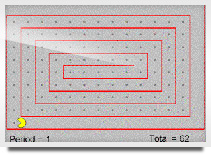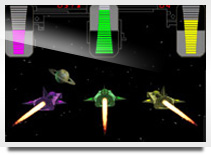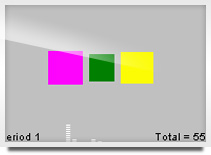The Client Screen
Below are several examples of game screens. These give clients feedback about how their brain is doing. In essence, your brain gets rewarded when it’s “in the zone”. The client plays using the brain, and anyone can do it.
When you sit down, many people ask, “how do I make it work?” Once you try it, you’ll start to realize:
- The more you try to play the game, the worse you do.
- The trick is to be focused on the screen, but “let it happen”. Don’t try to make it happen.
- Quit thinking. Thinking will slow the process down. Just do it.
- Sometimes, not paying attention at all works better. For others, paying more attention helps.
- Watching the game may not matter. You can even play with your eyes closed, at times. A lot of learning theory literature shows a single stimulus (beep) as reward is all that’s needed for learning.
These are just hints. Your brain will figure it out. Just as it’s hard to explain how to ride a bike, it’s hard to explain how to learn neurofeedback. But virtually everyone learns it quickly. Adults who think too much have the hardest time. They keep asking HOW to do it. Kids sit down and just start doing it. As soon as you quit thinking about it and start doing it, learning starts to occur. Playing is not a cognitive process. Thinking about it just gets in the way. Just allow it to beep.

For Mazes, you need to make the PacMan beep, stay yellow, and eat the dots. When your brain's not doing the right thing, the PacMan slows down and/or turns black.

For Space Race, the goal is to have the middle ship fire like it is above. However, the right and left ship should not be firing. When they don't fire, they sit quietly at the bottom of the screen. When the purple ship fires, it means your brain is making too much slow activity. The yellow ship firing means there's too much fast activity.

In Jumpbox, you want the middle box to grow as large as possible and to keep the right and left boxes as small as possible. Making the middle box larger represents creating more activation (a more alert, awake, attentive state). The goal is also to keep the purple or yellow boxes as small as possible. If they get larger, it means your brain is going too fast, too slow, or both. The small, white boxes give extra rewards when you maintain success for several seconds.

In 4Mation, this computer brings up pictures and breaks them into puzzle pieces. The grid could be 2×4 or 10×10. It randomly changes after completing each screen. You can load any set of pictures you want. For example, one therapist put cat pictures on the computer for a boy with Aspergers who really liked cats. The child loved it and instantly became more engaged.
Even for people who are not aware or not engaged, you can’t turn off your hearing. The brain hears the beeps, and responds. We’ve seen many examples where there was rapid response despite apparent lack of interest or attention. But that’s because of the sounds. When you hear more beeps, that means the brain is “getting it.”
Different systems offer different options, but most of them use beeps or other sounds that are clearly heard by the client, along with visual feedback. The sound may be the most powerful part of the training. It tells the brain “you did it”! It’s amazing how motivated people are to keep it beeping.
The therapist can control how much auditory and visual feedback is given by changing the goals and thresholds. Once the therapist sets the goal and doesn’t change them, the client determines how often it beeps.
More stimulating versus simpler games
There is ongoing debate about how engaging a game should be. For years, neurofeedback achieved consistent and long-lasting success using simple feedback with simple, and even boring, games. Using simple games meant that the person’s brain had to learn to maintain attention over time because the game itself provided low stimulation. We live in a world with constant stimulation. When that stimulation stops or slows down, attention for can rapidly suffer. Overstimulation makes it easier to stay engaged. But if you’re sitting in a class, in a meeting, or doing a boring task, many people struggle.
If you take a child with ADD, as an example, many times when they are highly stimulated, they pay attention very well. But when things get even a tiny bit boring, they cannot maintain attention. The idea of neurofeedback is that the brain needs to learn to engage in the state on its own. It will learn faster when it’s not being overstimulated. That concept is thought to apply to many conditions and symptoms, not just to ADD.
As more stimulating games become available (Sony PlayStation, DVD’s, etc.), there are many therapists who believe this more stimulating feedback is not as good as more basic games. They feel it doesn’t teach the brain to maintain its own engaged state rather than relying on stimulation. There are other clinicians and parents who say it’s much easier (on them) to keep people engaged with more stimulating games.
Not Proven
Over many years, it’s clear that training with simple, non-stimulating games produces long-term success with ADD and many other clinical problems. Patients have been followed for years. The training effect holds well.
We don’t know if highly stimulating games will produce the same learning effect over time. Will the results hold? Will the brain learn as well? There is no clinical or research experience yet to prove that. Many clinicians feel the more conservative approach is to continue using less stimulating games. Others suggest perhaps a mixture of more stimulating games can be used along with the less stimulating games. Only time will tell if these new games produce the long-term benefits that traditional, more simple games have achieved.
Providing rewards for learning to stay alert
Experienced therapists say that even inattentive or bored kids have success with simple games by using a reward strategy to keep the kids engaged.
On a few systems, a whole range of feedback becomes available if you teach the client the information on the therapist’s screen. There are numbers and graphs that are changing instantly on the therapist screen as the client trains. It can give the client direct and even precise feedback to their brain too. There is new information to train on using that approach. Most clients find watching their own brain activity to be very interesting and engaging.

